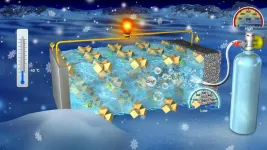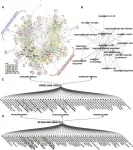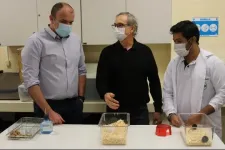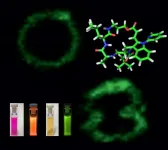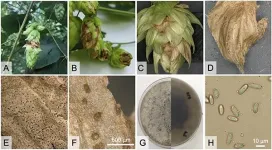(Press-News.org) A new technology could dramatically improve the safety of lithium-ion batteries that operate with gas electrolytes at ultra-low temperatures. Nanoengineers at the University of California San Diego developed a separator--the part of the battery that serves as a barrier between the anode and cathode--that keeps the gas-based electrolytes in these batteries from vaporizing. This new separator could, in turn, help prevent the buildup of pressure inside the battery that leads to swelling and explosions.
"By trapping gas molecules, this separator can function as a stabilizer for volatile electrolytes," said Zheng Chen, a professor of nanoengineering at the UC San Diego Jacobs School of Engineering who led the study.
The new separator also boosted battery performance at ultra-low temperatures. Battery cells built with the new separator operated with a high capacity of 500 milliamp-hours per gram at -40 C, whereas those built with a commercial separator exhibited almost no capacity. The battery cells still exhibited high capacity even after sitting unused for two months--a promising sign that the new separator could also prolong shelf life, the researchers said.
The team published their findings June 7 in Nature Communications.
The advance brings researchers a step closer to building lithium-ion batteries that can power vehicles in the extreme cold, such as spacecraft, satellites and deep-sea vessels.
This work builds on a previous study published in Science by the lab of UC San Diego nanoengineering professor Ying Shirley Meng, which was the first to report the development of lithium-ion batteries that perform well at temperatures as low as -60 C. What makes these batteries especially cold hardy is that they use a special type of electrolyte called a liquefied gas electrolyte, which is a gas that is liquefied by applying pressure. It is far more resistant to freezing than a conventional liquid electrolyte.
But there's a downside. Liquefied gas electrolytes have a high tendency to go from liquid to gas. "This is the biggest safety issue with these electrolytes," said Chen. In order to use them, a lot of pressure must be applied to condense the gas molecules and keep the electrolyte in liquid form.
To combat this issue, Chen's lab teamed up with Meng and UC San Diego nanoengineering professor Tod Pascal to develop a way to liquefy these gassy electrolytes easily without having to apply so much pressure. The advance was made possible by combining the expertise of computational experts like Pascal with experimentalists like Chen and Meng, who are all part of the UC San Diego Materials Research Science and Engineering Center (MRSEC).
Their approach makes use of a physical phenomenon in which gas molecules spontaneously condense when trapped inside tiny, nanometer-sized spaces. This phenomenon, known as capillary condensation, enables a gas to become liquid at a much lower pressure.
The team leveraged this phenomenon to build a battery separator that would stabilize the electrolyte in their ultra-low temperature battery--a liquefied gas electrolyte made of fluoromethane gas. The researchers built the separator out of a porous, crystalline material called a metal-organic framework (MOF). What's special about the MOF is that it is filled with tiny pores that are able to trap fluoromethane gas molecules and condense them at relatively low pressures. For example, fluoromethane typically condenses under a pressure of 118 psi at -30 C; but with the MOF, it condenses at just 11 psi at the same temperature.
"This MOF significantly reduces the pressure needed to make the electrolyte work," said Chen. "As a result, our battery cells deliver a significant amount of capacity at low temperature and show no degradation."
The researchers tested the MOF-based separator in lithium-ion battery cells--built with a carbon fluoride cathode and lithium metal anode--filled with fluoromethane gas electrolyte under an internal pressure of 70 psi, which is well below the pressure needed to liquefy fluoromethane. The cells retained 57% of their room temperature capacity at -40 C. By contrast, cells with a commercial separator exhibited almost no capacity with fluoromethane gas electrolyte at the same temperature and pressure.
The tiny pores of the MOF-based separator are key because they keep more electrolyte flowing in the battery, even under reduced pressure. The commercial separator, on the other hand, has large pores and cannot retain the gas electrolyte molecules under reduced pressure.
But tiny pores are not the only reason the separator works so well in these conditions. The researchers engineered the separator so that the pores form continuous paths from one end to the other. This ensures that lithium ions can still flow freely through the separator. In tests, battery cells with the new separator had 10 times higher ionic conductivity at -40 C than cells with the commercial separator.
Chen's team is now testing the MOF-based separator on other electrolytes. "We are seeing similar effects. We can use this MOF as a stabilizer to adsorb various kinds of electrolyte molecules and improve the safety even in traditional lithium batteries, which also have volatile electrolytes."
INFORMATION:
Paper: "Sub-Nanometer Confinement Enables Facile Condensation of Gas Electrolyte for Low-Temperature Batteries." Co-authors include Guorui Cai*, Yijie Yin*, Dawei Xia*, Amanda A. Chen, John Holoubek, Jonathan Scharf, Yangyuchen Yang, Ki Kwan Koh, Mingqian Li, Daniel M. Davies and Matthew Mayer, UC San Diego; and Tae Hee Han, Hanyang University, Seoul, Korea.
*These authors contributed equally to this work
This work was supported by NASA's Space Technology Research Grants Program (ECF 80NSSC18K1512), the National Science Foundation through the UC San Diego Materials Research Science and Engineering Center (MRSEC, grant DMR-2011924) and startup funds from the Jacobs School of Engineering at UC San Diego. This work was performed in part at the San Diego Nanotechnology Infrastructure (SDNI) at UC San Diego, a member of the National Nanotechnology Coordinated Infrastructure, which is supported by the National Science Foundation (grant ECCS-1542148). This research used resources of the National
Energy Research Scientific Computing Center, a DOE Office of Science User Facility supported by the Office of Science of the U.S. Department of Energy under Contract No. DE-AC02-05CH11231. This work also used the Extreme Science and Engineering Discovery Environment (XSEDE), and the Comet and Expanse supercomputers at the San Diego Supercomputing Center, which is supported by National Science Foundation (grant ACI-1548562).
To describe something as slow and boring we say it's "like watching grass grow", but scientists studying the early morning activity of plants have found they make a rapid start to their day - within minutes of dawn.
Just as sunrise stimulates the dawn chorus of birds, so too does sunrise stimulate a dawn burst of activity in plants.
Early morning is an important time for plants. The arrival of light at the start of the day plays a vital role in coordinating growth processes in plants and is the major cue that keeps the inner clock of plants in rhythm with day-night cycles.
This inner circadian clock helps plants prepare for the day such as when to make the best use of sunlight, the best time to open flowers ...
Citizen opposition to COVID-19 vaccination has emerged across the globe, prompting pushes for mandatory vaccination policies. But a new study based on evidence from Germany and on a model of the dynamic nature of people's resistance to COVID-19 vaccination sounds an alarm: mandating vaccination could have a substantial negative impact on voluntary compliance.
Majorities in many countries now favor mandatory vaccination. In March, the government of Galicia in Spain made vaccinations mandatory for adults, subjecting violators to substantial fines. Italy has made vaccinations mandatory for care workers. The University of California and California State University systems announced in late April that vaccination ...
ITHACA, N.Y. - Building lights are a deadly lure for the billions of birds that migrate at night, disrupting their natural navigation cues and leading to deadly collisions. But even if you can't turn out all the lights in a building, darkening even some windows at night during bird migration periods could be a major lifesaver for birds.
Research published this week in PNAS found that over the course of 21 years, one building sustained 11 times fewer nighttime bird collisions during spring migration and 6 times fewer collisions during fall migration when only half of the building's windows were illuminated, compared ...
Many mainstream depictions of immigration at the southern border of the United States paint a dark picture, eliciting imagery of violent gang members and child trafficking. But how many undocumented immigrants are really involved in this kind of activity? Many people may be surprised to learn the answer is far fewer than they think.
A new study from the Peace and Conflict Neuroscience Lab (PCNL) at the Annenberg School for Communication found that Americans dramatically overestimate the number of migrants affiliated with gangs and children being trafficked, and that this overestimation contributes to dehumanization of migrants, lack of empathy for their suffering, and individuals' views on immigration policy. In addition, the researchers developed and tested interventions to ...
Brazilian researchers have simultaneously demonstrated the mechanism linking high blood pressure to elevated intracranial pressure, validated a non-invasive intracranial pressure monitoring method, and proposed a treatment for high blood pressure that does not affect intracranial hypertension.
The study was supported by FAPESP and involved collaboration between researchers at São Paulo State University (UNESP) and Brain4care, a startup based in São Carlos. It could result in novel treatments for intracranial hypertension and its complications, including stroke. The main findings are reported in the journal Hypertension.
The researchers monitored blood pressure and intracranial pressure in rats for six weeks. “We set out to investigate ...
Biomolecules regulate the biological functions inside every living cell. If scientists can understand the molecular mechanisms of such functions, then it is possible to detect the severe dysfunction which can lead to illness. At a molecular level, this can be achieved with fluorescent markers that are specifically incorporated into the respective biomolecules. In the past, this has been achieved by incorporating a marker in the bio-molecule by completely rebuilding it from the beginning, necessitating a large number of steps. Unfortunate-ly, this approach not only takes a lot of time and resources, but also produces unwanted waste products. Researchers at the Universities of Göttingen and Edinburgh have now ...
If you're a beer drinker, you've noticed that hoppy beers have become increasingly popular. Most of the nation's hops come from the Pacific Northwest. However, commercial hop production regions have expanded significantly. In Michigan hop production nearly tripled between 2014 and 2017 and in 2019, Michigan growers harvested around 720 acres of hops.
Michigan hop growers contend with unique challenges as a result of frequent rainfall and high humidity during the growing season. In 2018, growers approached Michigan State University researchers and the Michigan State University's Plant & Pest Diagnostics lab with concerns about a leaf blight ...
ORLANDO, June 2021 - A new study co-authored by University of Central Florida researchers shows that pre-Columbian people of a culturally diverse but not well-documented area of the Amazon in South America significantly altered their landscape thousands of years earlier than previously thought.
The findings, published in the journal Proceedings of the National Academy of Sciences, show evidence of people using fire and improving their landscape for farming and fishing more than 3,500 years ago. This counters the often-held notion of a pristine Amazon during pre-Columbian times before the arrival of Europeans in the late 1400s.
The study, ...
Climate change and social inequality are two pressing issues that often overlap. A new study led by Princeton researchers offers a roadmap for cities to address inequalities in energy use by providing fine-grained methods for measuring both income and racial disparities in energy use intensity. Energy use intensity, the amount of energy used per unit floor area, is often used as a proxy for assessing the efficiency of buildings and the upgrades they receive over time. The work could guide the equitable distribution of rebates and other measures that decrease energy costs and increase efficiency.
Examining inequality in cities has been hampered ...
"The big mystery about plankton is what controls its distribution and abundance, and what conditions lead to big plankton blooms," said Dennis McGillicuddy, Senior Scientist and Department Chair in Applied Ocean Physics and Engineering at the Woods Hole Oceanographic Institution (WHOI).
Two new papers explore this question and provide examples of conditions that lead to massive plankton blooms with vastly different potential impacts on the ecosystem, according to McGillicuddy, co-author of both papers. Both papers also point to the importance of using advanced technology--including Video Plankton Recorders, autonomous underwater vehicles, and the Ocean Observatories Initiative's Coastal Pioneer Array--to find and monitor these blooms.
In one paper, Diatom Hotspots Driven ...
